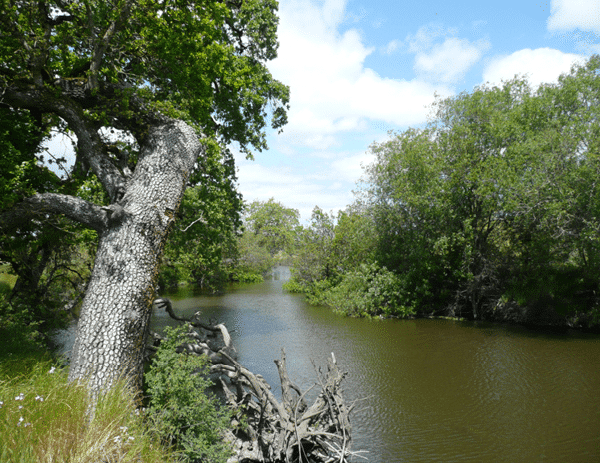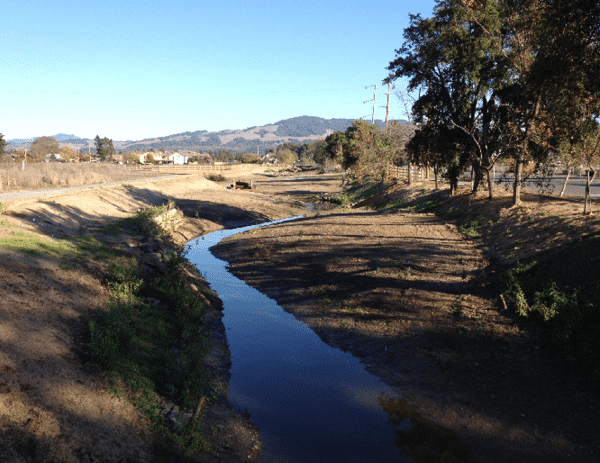The Freshwater Trust helps develop program to offset phosphorus and improve habitat in Northern California wetland
March 16, 2017
SACRAMENTO, CA — The Freshwater Trust (TFT) is working with the Northern California City of Santa Rosa to develop a program to reduce phosphorus and improve habitat quality in the Laguna de Santa Rosa.
While home to a number of threatened and endangered plant and animal species, and used for agriculture and recreation, the Laguna’s 14-mile wetland complex has been listed as impaired under the Clean Water Act. Sediment, phosphorus, mercury, bacteria, lack of oxygen and high temperatures are contributing factors.
TFT is working with the city’s water department, Santa Rosa Water, to enhance its regulatory approved “Nutrient Offset Program” by developing ways to quantify the impacts of restoration both in the Laguna and in upstream waterways. Installing vegetation buffers, removing invasive species, and reshaping and stabilizing stream channels can reduce phosphorus and nitrogen from entering the largest wetland in the region.
with the city’s water department, Santa Rosa Water, to enhance its regulatory approved “Nutrient Offset Program” by developing ways to quantify the impacts of restoration both in the Laguna and in upstream waterways. Installing vegetation buffers, removing invasive species, and reshaping and stabilizing stream channels can reduce phosphorus and nitrogen from entering the largest wetland in the region.
“Restoration has a powerful and proven ability to improve water quality,” said Alex Johnson, freshwater solutions director with TFT. “In fact, natural infrastructure can be just as viable a tool as engineered alternatives to address some of the issues the Laguna is currently facing.”
Although Santa Rosa Water’s Regional Treatment Plant reduces nitrogen and phosphorus levels during treatment, its federal discharge permit requires a “no net loading” of phosphorus. TFT is working with the water department to develop crediting alternatives designed to mitigate nutrient impacts through on-the-ground actions elsewhere in the watershed.
“By modeling different instream scenarios and actions, such as floodplain connectivity, sediment removal and more, we can quantify the pounds of nitrogen and phosphorus that could be prevented,” said Johnson. “This restoration can be turned into nutrient offset credits that count toward the city meeting its permit requirements.”
High levels of phosphorus and nitrogen find their way into waterways through runoff from agricultural fields. When concentrated, they starve water of oxygen. Over centuries, historic wetlands once part of the Laguna were drained and filled to convert for agriculture. Streams were also reshaped to reduce flood risks. The wetland could not function naturally and trapped nutrients in the sediment at the bottom of the Laguna’s main channel.
Santa Rosa Water has already completed projects to stabilize stream crossings and roadways to prevent erosion and worked with dairy owners to manage their lands, install vegetation buffers, and upgrade pasture areas.
TFT is currently working with Santa Rosa to test new methods of calculating nutrient offset credits on the Colgan Creek Restoration Project. The creek flows through the southwest part of Santa Rosa and drains into the mainstem Laguna. In 2014, the city began restoring a 1.2 mile long reach, changing the shape of the stream channel, installing a low-flow channel, adding inset floodplains and stream meanders, and installing native plants.
test new methods of calculating nutrient offset credits on the Colgan Creek Restoration Project. The creek flows through the southwest part of Santa Rosa and drains into the mainstem Laguna. In 2014, the city began restoring a 1.2 mile long reach, changing the shape of the stream channel, installing a low-flow channel, adding inset floodplains and stream meanders, and installing native plants.
More projects to reduce nutrients are planned, including planting native trees and shrubs along stream banks, reshaping stream channels to more natural contours, placing logjams, and removing polluted sediment through dredging.
“The Freshwater Trust is helping us determine how we remain in compliance with our permit as well as add as much value as possible from offset projects,” said Rita Miller, Santa Rosa Water deputy director of environmental services. “Because Santa Rosa has a council-approved Citywide Creek Master Plan, we’re seeking to integrate our permit compliance needs with our creek restoration goals.”
The Freshwater Trust has designed and operated water quality trading programs in Oregon for nearly a decade. Their largest program offsets the impacts of warm water entering the Rogue River from a wastewater treatment plant through the planting of native trees and shrubs to generate shade. The amount of sun blocked is translated into credits and purchased by the city of Medford.
“Nature has a value,” said Johnson. “We’re proud to present natural solutions that help cities meet compliance and also make a meaningful difference for the entire watershed and thus, all the life and industry depending upon it.”
Photos courtesy of the City of Santa Rosa.
#Colgan Creek #Laguna #Laguna de Santa Rosa #Northern California #phosphorus #Sacramento #Santa Rosa #Santa Rosa Water #wetland
